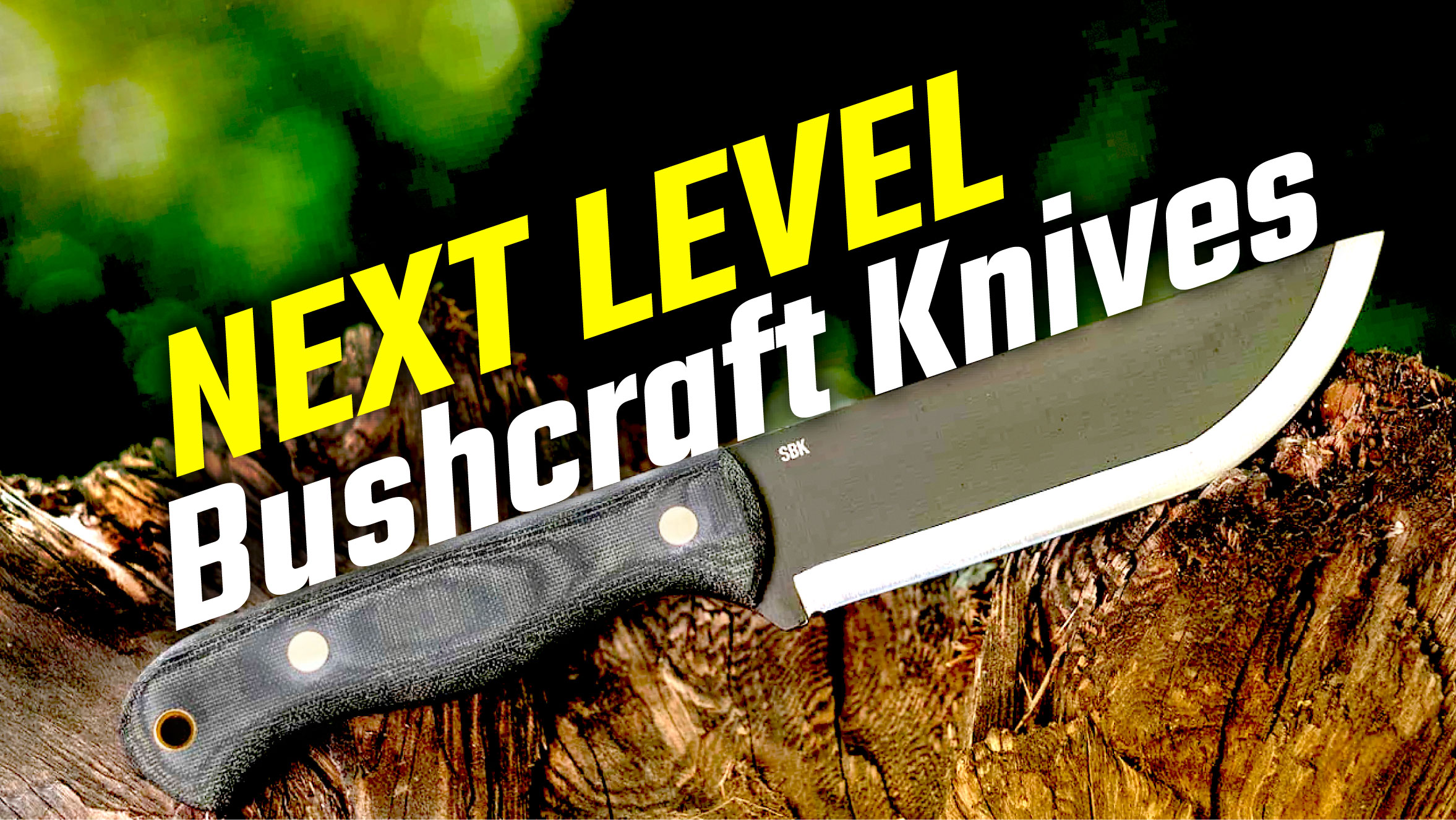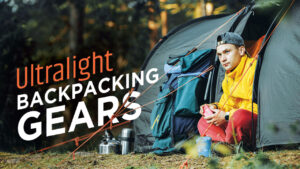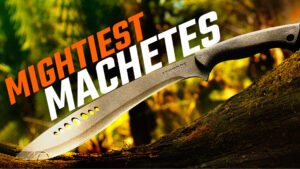Best Bushcraft Knives for Survival: Tools for the Great Outdoors
Bushcraft: Nature’s cheat codes for surviving the great outdoors, handed down through the ages. When it comes to bushcraft, a killer bushcraft knife is the ultimate must-have. Welcome to the wild world of bushcraft knives! Get ready for a full-on rundown of the absolute best ones out there. Let’s dive in! Whether a bushcraft newbie or a seasoned camper, having the perfect knife can be the ultimate game-changer for your wilderness survival skills.
Characteristics of a Good Bushcraft Knife
Let’s take a moment to discuss the characteristics that define a good bushcraft knife before we go on to the specific options available for knives. These characteristics will assist you in selecting the most suitable tool for your survival requirements.
Type and Material of Blade
When it comes to a bushcraft knife, the blade is what matters most. It should be made from only the best materials, like carbon or stainless steel. No rust, no trouble! The question is whether to steel or not to steel. You can choose between carbon and stainless steel if you want to. Steel that is made of stainless steel is like a fighter. No rust, no trouble. Perfect for places that are wet and sticky. Carbon steel is better than diamonds for keeping an edge and cleaning on the go.
How Long and How Thick the Blade Is
About 4 to 6 inches is how long the blade should be. This size is just right—it’s long enough to do many different things but short enough to keep your balance and accuracy. The blade shouldn’t be too thick so that it can’t cut well, but it should be wide enough to handle tough jobs like batoning wood or carving.
Take care of the material and design.
A bushcraft knife must have a handle that is both comfy and strong. Material like wood, Micarta, or G-10 is often used to make handles. The design should be ergonomic, meaning it should fit easily in your hand so you don’t get tired after using it for a long time.
Complete Tang vs. Partial Tang
A full-tang knife has a blade that goes through the handle. This makes the knife very strong and long-lasting. The knife is usually less intense when the edge is only partially connected to the handle. A full-tang knife is the best choice for tough jobs.
Quality of Sheath
It would be best to forget to get a good case. It should be strong, last long, and give you a few different ways to carry it, like belt loops or MOLLE clips.
Durability, adaptability, and comfort are essential.
Besides these qualities, a good bushcraft knife should be long-lasting, useful in many situations, and easy to hold and use. The tool should be able to do many things, such as slicing, carving, hitting, and adding feathers.
The Best Bushcraft Knives You Can Buy
Now, let’s look at the best bushcraft knives on the market. Each one has its attributes and benefits.
L.T. Wright GNS
The L.T. Wright GNS (Go No Show) is a high-quality bushcraft knife that does many great things for survival. The 4.5-inch blade is made of high-carbon O1 tool steel, known for keeping its edge well and being easy to clean. The GNS is built with a full tang, which makes it durable in harsh conditions.
The GNS handle is made from natural materials like curly wood, making it valuable and friendly to look at. The ergonomic shape makes it easy to hold on to for long periods. The knife comes with a stylish and practical handmade leather sheath. You can count on the L.T. Wright GNS to be a reliable tool for bushcraft activities, whether carving, batoning, or making food.
Morakniv Garberg
The Morakniv Garberg is a well-known Swedish bushcraft knife among people who like being outside. It has a 4.3-inch stainless steel blade made from Sandvik 14C28N steel, which doesn’t rust and stays sharp for a long time. This makes it a good choice when it’s wet and sticky outside.
The complete tang design of the Garberg makes it solid and stable. Its handle is made of long-lasting polyamide, which makes it easy to hold on to even in bad weather. You can carry the knife in different ways with the multi-mount sheath device that comes with it. Outdoor travellers like the Morakniv Garberg because it is strong, can be used in many ways, and doesn’t rust.
Ontario Field Knife for Bushcraft
The Ontario Bushcraft Field Knife is a good choice if you want a challenging and helpful bushcraft tool. The 4.1-inch blade is made of 5160 carbon steel, which makes it a strong and long-lasting option. The blade’s high carbon content makes it easy to sharpen and keeps its edge well maintained.
Walnut is used to make the handle of the Bushcraft Field Knife. It looks great and feels good in your hand. It’s more durable because it has a complete tang design, so you can confidently take on challenging jobs. This knife has a fabric sheath that can be used in several ways. The Ontario Bushcraft Field Knife is a good pick if you want a reliable bushcraft knife that won’t break the bank.
The KA-BAR Kephart and Becker
A standard bushcraft knife, the KA-BAR Becker Kephart , was made with the help of famous outdoorsman Ethan Becker. The blade is 5.125 inches long and made of 1095 Cro-Van steel, which is tough and easy to clean. People who like traditional styles will like this knife because it resembles the original Kephart design.
The handle on the Becker Kephart is made of Grivory, a material that is easy to hold and gives you a good grip. It has a complete tang design that makes it last longer. The sheath that comes with the knife is MOLLE-compatible, which makes it easy to connect to your gear. The KA-BAR Becker Kephart is a solid and helpful bushcraft knife that can be used for carving, chopping, and smaller jobs.
Benchmade Puukko Knife Model
The Benchmade Puukko Knife is a new take on the timeless form of the Scandinavian Puukko. The 3.75-inch blade is made of high-quality CPM-3V steel, known for being tough and keeping its edge. This stainless steel blade is very good at resisting rust, so that it can be used in wet places.
The handle of the Puukko is made of Santoprene, making it easy to hold on to even when wet. It is built to last with a complete tang design. The knife comes with a stylish leather handle that looks good and is helpful. Benchmade’s Puukko Knife can be used for many bushcraft jobs, from cutting wood to making food.
How to keep and care for a bushcraft knife
Having a good bushcraft knife is just the beginning. For your knife to stay in great shape, you must care for and maintain it properly. Here are some essential tips to keep your valuable knife in the wild.
Clearing up
Use soap and water to clean your knife well after each use. Ensure to get rid of any food or trash still on the blades. Thoroughly dry the knife before putting it away to keep it from rusting.
Make it sharp
Sharpen your knife often to keep its edge. You can use an iron or a steel wool.
Or a sharpener that you can take with you. Learn how to sharpen your knife to keep it in good shape in the field.
Keeping things
Maintain your knife in an excellent, dry spot. If you keep it in a sheath for a long time, water can build up and cause it to rust. Put a thin layer of oil on the blade to prevent rust when not using the knife often.
Take care of safety.
When you use your bushcraft knife, you should always be careful. Keep your fingers away from the blade’s path, and make sure your hands are in the right place. If this is your first job, get help and practice in a safe place.
Tips for Picking the Best Bushcraft Knife
Choosing the right bushcraft knife can be tricky because there are so many. When you make your choice, here are some things to think about:
Costs
Set a price range for your bushcraft knife. Quality costs money, but there are choices for people with different budgets. You should buy the best knife you can afford because having one in the woods is imperative.
Aims and Purpose
Take some time to think about what you want to do with the knife. Are you going to do a lot of heavy chopping and hitting, or are you going to do more delicate work like cutting and making food? Pick a knife that works for what you want to do.
How Much Experience You Have?
Your level of knowledge is a big part of which bushcraft knife you should choose. For beginners, knives that are easier to use and can be used in a variety of situations may be best. On the other hand, experienced bush crafters may want knives made specifically for their skills.
Your Own Choices
You can choose based on things like the handle’s material, the blade’s style, and the sheath’s design. It’s essential to pick a knife that fits your hand well and looks good.
What You Need to Know About Bushcraft Knives
A bushcraft knife is a practical outdoor tool that can be used for many different jobs. Look at these important bushcraft skills and tricks you can do with your knife.
Weapons
Building fires is one of the most essential survival skills. You can make feather sticks, cut up firewood, and start a fire by striking a ferrocerium rod with your bushcraft knife. You can make driving a fire in the woods much easier if you know the right way.
Making a shelter
If you want to build a shelter, you need a bushcraft knife. It helps cut cloth, cordage, and trees. Your knife is a handy tool for making a lean-to, a trash hut, or a tarp shelter.
Making food
For example, you can clean and gut fish with your bushcraft knife and slice and dice veggies. A blade that is accurate and sharp makes the job easier and more fun.
Tools and gear for crafting
Your knife can make tools and gear if you need to survive. You can use plant fibres to make rope, traps and snares, and even tools out of wood. You can do anything if you know what you’re doing and have a good bushcraft knife.
Safety Takeaways
When you use a bushcraft knife, safety is paramount. Make sure you and those around you stay safe when you’re outside by following these safety tips:
Correct Method
Always cut and carve the right way to keep accidents from happening. Stay in charge of the knife at all times, keep your fingers away from the blade, and cut away from your body.
Watching over
If you’re new to bushcraft, you should get help and advice from people who have done it before. Getting advice from a guide on how to do things and stay safe can be very helpful.
Final Thoughts
A good bushcraft knife is an essential tool for people who are into survival and bushcraft. From the L.T. Wright GNS to the Benchmade Puukko Knife, each blade in this guide has features that suit various needs and tastes. Consider your income, how you plan to use the knife, your level of experience, and your preferences when you buy a bushcraft knife.
Remember that getting a bushcraft knife is only the start of your outdoor journey. If you want your knife to work well in the wild, you must take care of it and maintain it properly. You will be ready for the difficulties of the great outdoors if you have the right knife and know how to use it.
FAQ
What is the main reason to carry a bushcraft knife during an emergency?
In escape situations, a bushcraft knife can be used for many things. Cutting, carving, chopping, preparing food, making tools, and building houses are some of its primary uses. It’s a helpful tool that can be used for many things in the wild.
How are the blades of bushcraft knives made different between carbon steel and stainless steel?
People know that stainless steel blades don’t rust and don’t need much upkeep. They can handle situations that are wet and sticky. But carbon steel blades keep their edge better and are easier to sharpen in the field. The choice you make will depend on your wants and the situation you’re in.
How do I keep my bushcraft knife’s edge sharp in the field?
A sharpening stone or honing stick that you can take with you into the field is what you need to keep the edge of your knife sharp. Learn how to sharpen, and do it often to keep the edge nice and sharp. To keep the blade’s sharp edge, you can also stop it.
Can I use a bushcraft knife to protect myself in an emergency?
A bushcraft knife is mainly used for survival jobs, but it can be used for self-defence in dangerous situations. It’s not a tool made just for self-defence. It’s essential to avoid de-escalating and to get help whenever possible.
Is it against the law to carry a bushcraft knife in some places?
Yes, the laws about carrying knives change from place to place. Before you take a bushcraft knife, ensure you know your area’s rules and regulations. In some places, the length of the blade is limited, and some kinds of knives may not be allowed. Always follow the laws in your area.
Can I hunt and skin animals with a bushcraft knife?
You can hunt with a bushcraft knife and skin animals with it. Pick a knife with a blade that is the right size and shape for the job. Ensure the edge is always sharp to get clean cuts when preparing the game.
What’s the best way to keep a carbon steel bushcraft knife from rusting?
It is best to keep a carbon steel knife clean and dry when not used so it doesn’t rust. A thin coat of oil on the blade will act as a barrier to keep it safe. The edge will last longer if you take care of it and oil it regularly.
Is there a sure way to feather-stick with a bushcraft knife?
Making small curls of wood that look like feathers is called feather-sticking. It helps start a fire. Cut dry wood along the grain with a sharp bushcraft knife in minor, tight cuts to make a feather stick. By practising this method, you can get thin curls that are easy to set on fire.
What’s the benefit of a full-tang knife for jobs in the bush?
The blade of a full-tang knife goes through the handle, making it very strong and long-lasting. This style works well for demanding jobs like cutting and striking wood, which makes it a good choice for bushcraft.
Can you suggest a good bushcraft knife for newbies that won’t break the bank?
The Ontario Bushcraft Field Knife discussed in the piece is a good choice for beginners who won’t break the bank. It’s built to last and doesn’t cost too much, so it’s a good choice for people new to bushcraft.




